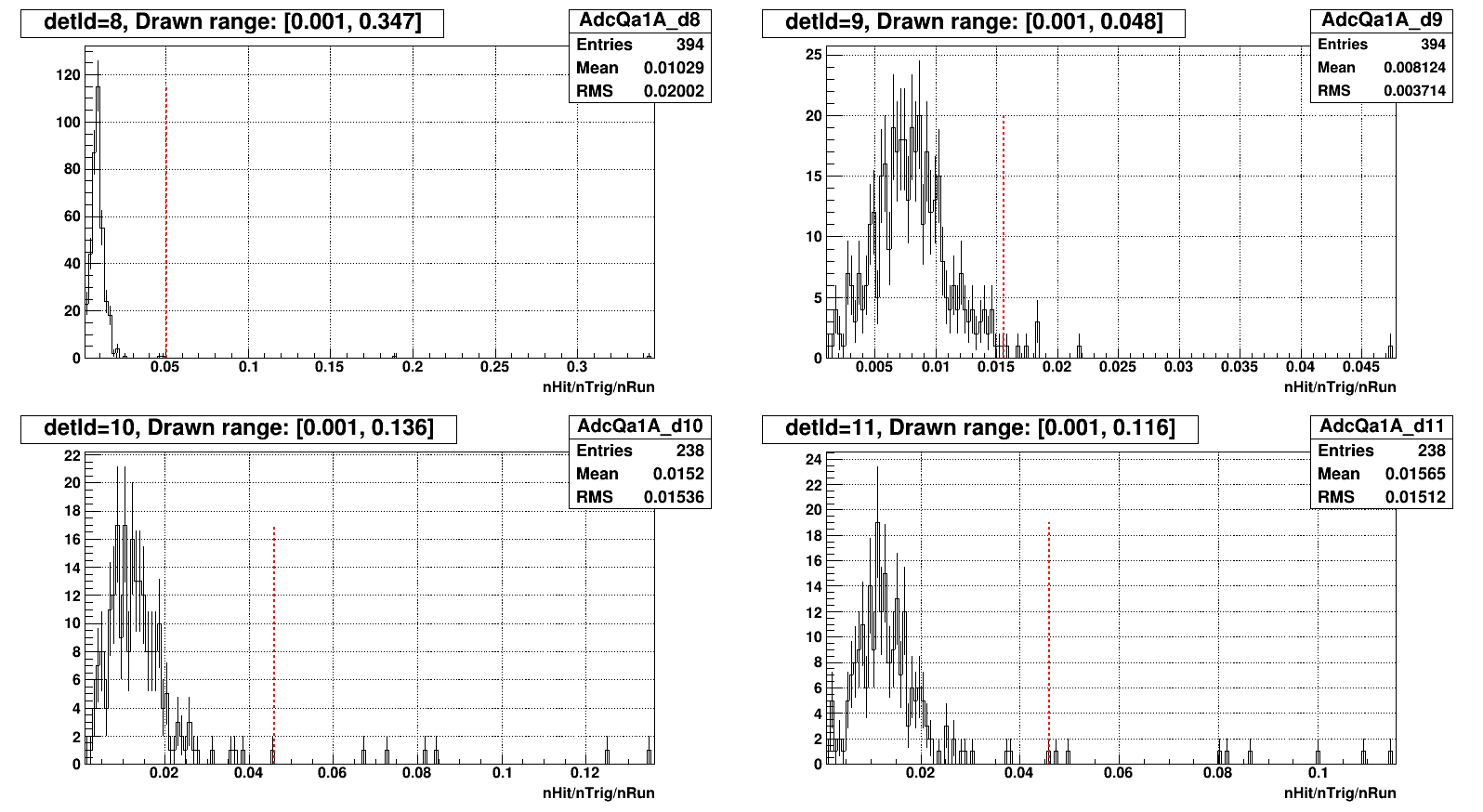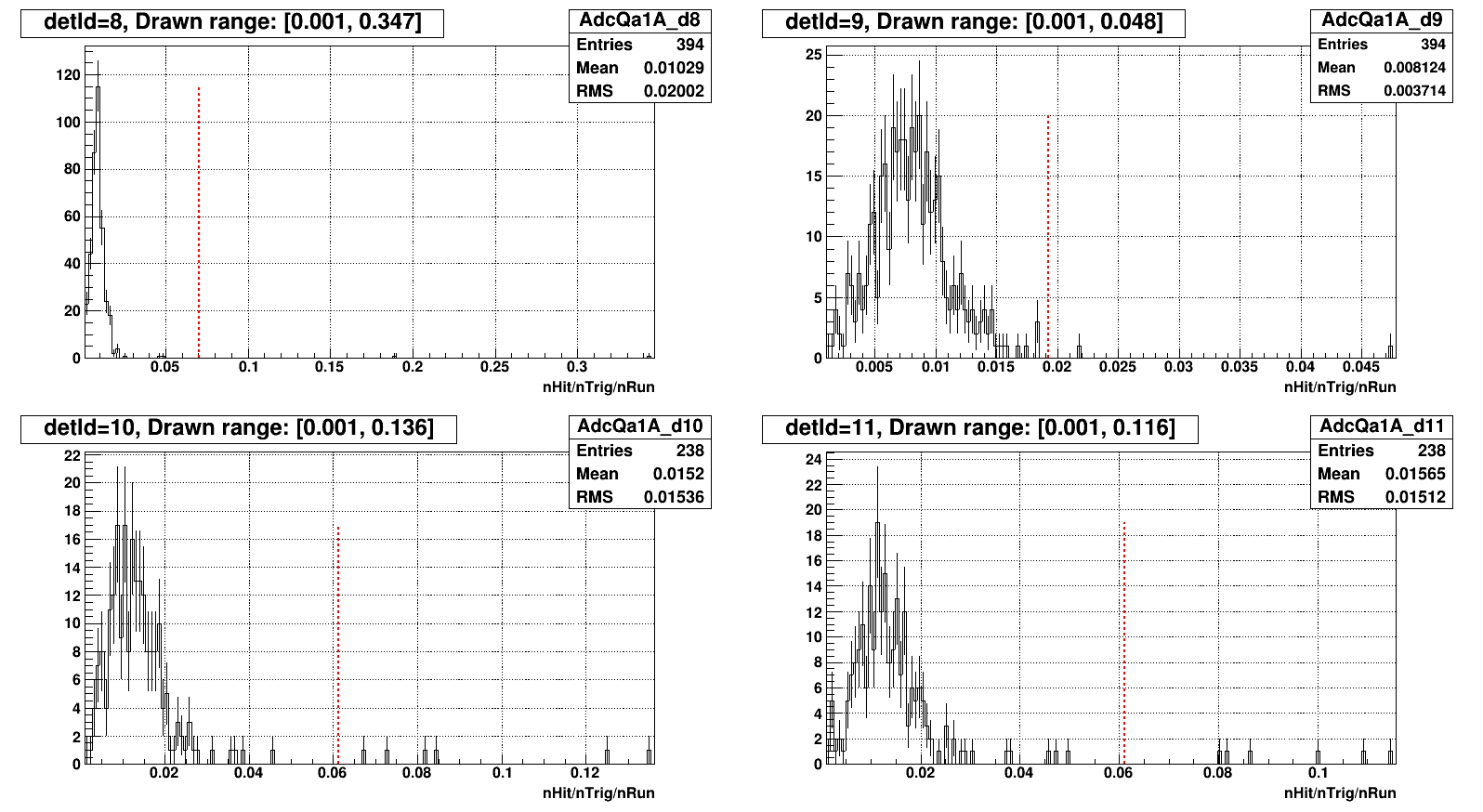- ckimstar's home page
- Posts
- 2020
- 2019
- December (1)
- November (1)
- October (1)
- September (4)
- August (4)
- July (3)
- June (2)
- May (2)
- April (2)
- March (5)
- February (1)
- January (1)
- 2018
- December (5)
- November (1)
- October (3)
- September (2)
- August (3)
- July (4)
- June (3)
- May (2)
- March (4)
- February (4)
- January (5)
- 2017
- December (2)
- November (3)
- October (4)
- September (5)
- August (6)
- July (2)
- June (3)
- May (4)
- April (5)
- March (4)
- February (3)
- 2016
- My blog
- Post new blog entry
- All blogs
Decision of bad or hot in FMS - update
- Trying to set a proper standard to hot channels decision (attached report)
//-------------------------------------------------------------------------------------------------
- Follow-up discussion: tightness of Mean + x * sigma, results obtained from day 80-81
a. x = 2 ( judge a cell potentially hot if nHit / nTrig / nRun > Mean + 2 * RMS )

Potential hot channels: 8, 221
Potential hot channels: 8, 566
Potential hot channels: 9, 139
Potential hot channels: 9, 196
Potential hot channels: 9, 230
Potential hot channels: 9, 282
Potential hot channels: 9, 315
Potential hot channels: 9, 429
Potential hot channels: 9, 430
Potential hot channels: 9, 446
Potential hot channels: 10, 59
Potential hot channels: 10, 60
Potential hot channels: 10, 71
Potential hot channels: 10, 151
Potential hot channels: 10, 153
Potential hot channels: 10, 256
Potential hot channels: 11, 22
Potential hot channels: 11, 72
Potential hot channels: 11, 150
Potential hot channels: 11, 175
Potential hot channels: 11, 209
Potential hot channels: 11, 210
Potential hot channels: 11, 282
Potential hot channels: 11, 286
Total: 24
b. x = 3 (relatively loose compared to x = 2)

Potential hot channels: 8, 221
Potential hot channels: 8, 566
Potential hot channels: 9, 429
Potential hot channels: 9, 430
Potential hot channels: 10, 59
Potential hot channels: 10, 60
Potential hot channels: 10, 71
Potential hot channels: 10, 151
Potential hot channels: 10, 153
Potential hot channels: 10, 256
Potential hot channels: 11, 22
Potential hot channels: 11, 72
Potential hot channels: 11, 150
Potential hot channels: 11, 209
Potential hot channels: 11, 210
Potential hot channels: 11, 282
Total: 16
- Follow-up discussion: response to Akio's comment (May 1, mail exchange)
Some of bad channels shown in page 6 may still give similar # of hits.
So I almost agree with "checking ADC spectra can’t be avoided" in page2.
"Almost" because if a cell has too high/low HV online, thus has gain_corr much larger/smaller than 1.0,
"# of entries in high ADC (ex. ADC = 100)" will be too high or low, even in minbias/st_physics data.
More so in st_fms stream data due to trigger bias. Yet the cell may be still usable.
Just don't cut hard on it if using ADC, or use energy (with best known gain_corr).
And it is good to look at relatively high adc/energy part (your ADC~100 is good, or equivalent energy)
away from steep part near pedestal
It's rather a heads-up message + marking their ADC distribution in red.
The judgment for the masking will be done by checking ADC spectra, by human eye.
- To help one make better judgment with ADCs,
a. Scale down by its bit shift, if BS > 0
b. Use the entries in ADC = 100
c. Compare with channels around the suspect, to prevent confusion by rapidity effect
- Following ADC spectra shows exmaple of marking potential hot channels
a. Two channels marked: d11_ch209 and d11_ch210.
b. Especially d11_ch210 is the one caused "zgg bump" in last year thus masked out so far
c. Both marked channels got almost factor 10 larger # of entries compared to the other channels in same canvas
d. It is apparent d11_ch210 should be masked out, but for ch209 I'm not sure -
when I checked ch209's ADC = 100, its # of entries are a few tenth, which is similar to the others except ch210.
Then this channel should NOT be masked out, if I understood Akio's explanation correctly.
.png)
- Update: after discussion, Akio and I agreed earlier ADC bins (ex. ~ADC 50) also should be checked, too.
a. Even if a potential hot cell has similar # of entries in ADC ~100, if it's very hot in ADC ~50, it still should be masked out.
b. Actually ADC ~50, or even ADC ~30 is NOT a negligibly small ADC (energy),
especially combined with large # of entries its effect can be devastating
//-------------------------------------------------------------------------------------------------
- Update (May 23): after discussion at May 20 meeting / personal discussion with Akio
a. Added hit energy distribution on top of ADC: blue distribution
b. Hit E = ADC x gain x gainCorr
c. To draw ADC/hit E in similar scale, hit energy was multiplied by 10 ( ex. hit E in x = 50 means 5 GeV)
.png)
- Still I'm not sure how to utilize this to hot/bad channels QA
a. Converting ADC to hitE simply push or pull the overall distribution:
it can be used as parameter of calibration status, but I'm not sure how it can help judging bad/hot channels
b. To get the hitE one need reliable set of gainCorr - but this bad/hot channels QA is prerequisite procedure before calibration.
Then one should rely on other gainCorr from previous or other days' calibration. Can it be trusted?
Especially no gainCorr set exists before RUN15pptrans day 77. The only gainCorr set now I have is day 80-81.
If I try bad/hot channels QA for day 66, can I trust gainCorr for day 80? Personally I don't think so.
c. I cannot come up with proper QA standard using hit energy - please advice.
I'll keep this feature but bad/hot channels QA won't be changed for now
- Akio and I agreed # of masked out channels should be as minimal as possible before calibration starts
- ckimstar's blog
- Login or register to post comments
